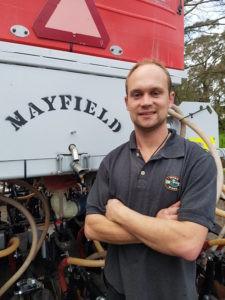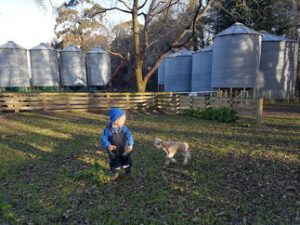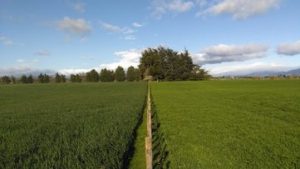At Cryermalt we source all of our New Zealand malt from Malteurop New Zealand. Henry Reynolds is one of the local barley growers that supplies Malteurop NZ’s malting plant in Marton. Based in the Wairarapa, near Masterton, he’s in close proximity both to the ‘craft beer capital’ and the malting plant, so the grain doesn’t have far to travel between the farm, the maltster and the brewer.
 Henry and brother Pascoe recently took over the family farm from parents Jim and Lois. Henry now runs the cropping side of the business and Pascoe manages the livestock, trading as Mayfield Bros Partnership. The farm has been in the family since 1865 and Henry and Pascoe Reynolds are the fifth generation. The family has always grown cereals, including barley, oats and wheat, and have been growing barley for at least three generations.
Henry and brother Pascoe recently took over the family farm from parents Jim and Lois. Henry now runs the cropping side of the business and Pascoe manages the livestock, trading as Mayfield Bros Partnership. The farm has been in the family since 1865 and Henry and Pascoe Reynolds are the fifth generation. The family has always grown cereals, including barley, oats and wheat, and have been growing barley for at least three generations.
They decided to introduce malting barley about 10 years ago, gradually phasing out feed barley, and now grow barley solely for the brewing industry. Henry wants to develop this side of the business further, recognising the demand for high quality malt for the flourishing craft brewing industry.
Henry is one of the smaller-scale barley growers supplying Malteurop NZ, and has a range of different crops, and his own grain storage facility for up to 500 tonnes. Other crops this year include ryegrass, pak choy, red chard, red and white clover and seed oats. The farm is surrounded by stunning scenery. “It’s just an amazing place to be, every day is like being on holiday,” says Henry.
One of the main differences that distinguishes their methods from those of other growers is that they direct-drill everything – this means creating a small slot for each seed and dropping the seed in one side and the fertiliser in the other for optimal fertilisation. This was a move by Henry’s parents when they ran the farm, consistent with their ethic of using environmentally sustainable and less energy intensive methods. They have their own planting machinery and also do their own fertilising and harvesting, getting contractors in for the spraying.
 The cropping and livestock are complementary, as the same land can be used for both – the Reynolds can literally turn pasture into crop in a single day, and it can be converted back almost as quickly by re-grassing after harvest. Mayfield Bros finish 6000 lambs a year for export, and have just passed peak lambing, at the end of winter. The busiest times of year for livestock and cropping dovetail quite nicely, says Henry. “[Winter] is really quite boring for me, because you’re just keeping things ticking over, digging holes for drainage and trying to keep off surface water, and maintaining machinery.”
The cropping and livestock are complementary, as the same land can be used for both – the Reynolds can literally turn pasture into crop in a single day, and it can be converted back almost as quickly by re-grassing after harvest. Mayfield Bros finish 6000 lambs a year for export, and have just passed peak lambing, at the end of winter. The busiest times of year for livestock and cropping dovetail quite nicely, says Henry. “[Winter] is really quite boring for me, because you’re just keeping things ticking over, digging holes for drainage and trying to keep off surface water, and maintaining machinery.”
Although the harvest is really hard work, long hours and the busiest time for him, Henry says it’s the season he enjoys the most, as he gets to see the results of the work that’s gone in over the entire year.
Planting times vary from year to year depending on the weather, and growers have to be able to predict the weather fairly accurately, or risk too much moisture in the early stages. For example, Henry explains that the process is not the same for growers in the North Island as for the South Island, where conditions are quite different. Henry utilises both autumn and spring planting seasons, which require slightly different management. Throughout the growing season he applies various combinations of fertiliser, growth regulator, insecticide and weed spray. They are now gearing up for spring planting, which will take place over 2-3 weeks from late September to early October, and will be harvested in late January to mid-February. The autumn crop went in this year in May and will be harvested between Christmas and New Year.
 Growing malting barley is much riskier and more challenging than feed barley. For a start, growers have to make an assumption as to what size their malt contracts will be from Malteurop NZ at the end of the year, and allocate crops accordingly. Brewers’ malt requires a very narrow specification for the barley in terms of protein content. Planting times are much more critical, and fertilising the right amount at the right times is a delicate business. But it’s also more rewarding – both in terms of financial return and personal satisfaction, says Henry; it’s really satisfying when you get it right.
Growing malting barley is much riskier and more challenging than feed barley. For a start, growers have to make an assumption as to what size their malt contracts will be from Malteurop NZ at the end of the year, and allocate crops accordingly. Brewers’ malt requires a very narrow specification for the barley in terms of protein content. Planting times are much more critical, and fertilising the right amount at the right times is a delicate business. But it’s also more rewarding – both in terms of financial return and personal satisfaction, says Henry; it’s really satisfying when you get it right.
Managing nitrogen levels in the soil is probably the trickiest aspect, and the most crucial, as this directly affects protein levels in the finished grain and therefore in the malt. The soil is tested at a depth of 600mm for nitrogen levels, at regular intervals across the barley field. There are up to three applications of nitrogen during ‘tillering’ for an autumn crop. For spring-sown crops it can be less, depending on seasonal rainfall.
Tillering (not to be confused with tilling, which they don’t do!) is when the plant sends out extra shoots from the root or bottom of the stalk, resulting in bulking of the plants and more seed heads. This is encouraged by growers by the careful application of nitrogen at critical growth stages.
 For the last few years the Reynolds have been growing the two main New Zealand barley varieties, Jimpy and Fairview, both developed by Malteurop NZ specifically for local conditions. This year Henry is only growing Jimpy, which is ideal for autumn sowing, with better resilience to wet conditions.
For the last few years the Reynolds have been growing the two main New Zealand barley varieties, Jimpy and Fairview, both developed by Malteurop NZ specifically for local conditions. This year Henry is only growing Jimpy, which is ideal for autumn sowing, with better resilience to wet conditions.
Henry will be joining us at the Brewers Guild of NZ Conference on a panel on barley and malting in New Zealand, where he’ll talk more about the tricks of the trade. More details on this to come.
On the subject of beer, Henry said he stopped for a box of Moa Imperial Stout on the way back from the South Island recently and was an instant convert. He’ll often find himself sitting back with a beer in hand at the end of a long day, and marvel at how much goes into making this humble, refreshing drink – the planting, maintenance and harvesting of barley being just the beginning. Henry even finds the time for a bit of home brewing. He first gave it a go while cropping in Timaru, and now brews his own from grain, which he actually does in a small pot still. He originally acquired this for distilling, but after a questionable batch of whiskey decided to dedicate it exclusively to beer brewing.


